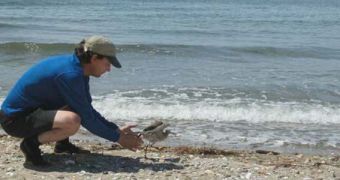A group of investigators at the United States Geological Survey (USGS) recently conducted a new study on a species of shorebird called the bar-tailed godwit, which is the ultimate marathoner in the bird world. These birds are able to circumnavigate the entire Pacific Ocean in a single go, while also sensing large-scale weather patterns affecting the entire basin.
During their transoceanic migrations, the godwits cover thousands of miles, most of them over the water. Any type of resistance, such as that provided by winds flowing in the opposite direction, or by large storms, can easily drive up the amount of energy they need to reach their destinations.
As such, it makes evolutionary sense for them to develop the ability to sense any atmospheric patterns that may be detrimental to their travel. Exactly how this mechanism works is another issue entirely, and one in which researchers are very interested. Mimicking such an ability in aircraft, for example, could reduce the incidence of accidents and other in-flight incidents.
USGS scientists determined that the bar-tailed godwits are also able to optimize their routes based on these predictions, both before departing and during flight. For this research, scientists captured and tagged a number of birds from a site called Roebuck Bay, in western Australia.
The team likens the way these birds calculate their routes to airline pilots examining weather maps before they leave an airport. Unlike pilots though, godwits are able to predict weather conditions ahead, allowing them to always enjoy the best possible wind conditions for their non-stop travels.
“We think that these behaviors represent a previously unknown cognitive ability that allows bar-tailed godwits to assess changes in weather conditions across widely separated atmospheric regions in different parts of the Pacific Ocean and to time their migration patterns accordingly,” explains USGS emeritus scientist Robert Gill, Jr., the lead author of the new study.
The research effort also included researchers from the US National Oceanic and Atmospheric Administration (NOAA), the University of Groningen, and the NIOZ Royal Netherlands Institute for Sea Research. The work is detailed in a recent issue of the journal Animal Behaviour.
Godwits are world champions when it comes to marathons. Their usual flight path is from breeding areas in Alaska to wintering areas in New Zealand. They spend around 10 days in the air, never landing to eat or rest once.
“There are a number of broad-scale prevailing wind patterns through the Pacific Ocean, and the godwits take advantage of these winds to facilitate successful migration between their wintering and breeding areas. These wind patterns appear to be teleconnected, or linked, across broad expanses of the Pacific Ocean,” Gill goes on to say.

 14 DAY TRIAL //
14 DAY TRIAL //